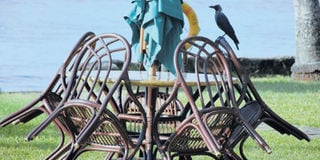Ridge tormented by the Indian crow

An Indian Crow perches on a seat at Serena Beach Resort in Mombasa. They are said to be very intelligent birds. PHOTO| WACHIRA MWANGI
What you need to know:
- While Mombasa residents are learning to live with it, homeowners in Vipingo Ridge are using a variety of tactics to rid themselves of the annoying bird.
- Mr Mike Round-Turner, the general manager of the estate, says there are more than 247 species of birds in a Mombasa County, where the invasive crow rules the skies.
With its black body beak and legs, and grey feathers on the neck and breast. you cannot mistake the Indian crow. You cannot miss it with its repeated “caw, caw, caw!) or a nasal ‘kaan kaan’.
The Indian house crow (kunguru in Kiswahili) is highly intelligent and notorious for killing African birds, crabs and beach cleaners along the Kenyan coast.
They also steal food and irritate customers in restaurants with their raucous calls.
This voracious bird is not to be confused with Kenya’s indigenous pied crow. The pied crow has that distinctive white chest and belly.
A native of the Indian sub-continent, the Indian crow is not particularly liked, thanks to its scavenging habit and daring, which are undeterred by the presence of humans.
The bird has also been called the world’s most destructive among the 51 species and subspecies of crow.
While Mombasa residents are learning to live with it, homeowners in Vipingo Ridge are using a variety of tactics to rid themselves of the annoying bird.
Mr Mike Round-Turner, the general manager of the estate, says there are more than 247 species of birds in a Mombasa County, where the invasive crow rules the skies.
Mr Round Tuner says all the bird life is attributable to a control programme developed by residents of the posh estate.
However it comes at a cost, and quite a bit of work.
On the day we meet him, Mr Duncan Mitchell, a home owner at the ridge and a conservationis, expresses great annoyance with the crow.
He was born in Zimbabwe, worked as a wildlife guide in the country, and has always held a special place in his heart for birds.
But he would like to see and end to the Indian crow menace at all costs. When he moved to the estate, he expected to wake up to the trills or chirping of more likeable birds. But soon the Indian crows invaded the estate and killed many of the indigenous birds.
MANGO FOREST
Those that survived moved deeper into the nearby mango forest. The bird’s songs were replaced by the persistent cawing of the Indian crow.
Mr Mitchell consequently set up an initiative with the ridge golf caddies, who spent most of their days at the golf course.
They set crow traps, and managed to eliminate up to 150 crows a month, but the clever bird soon recognised human faces and would avoid the traps.
He began to encourage the caddies and villagers to collect crow eggs and could pay them for every egg they took to him.
“I work with the young kids near the ridge to collect the crow eggs. I have set up a fund, which people around here contribute to. I pay Sh10 per egg but right now there are not so many eggs so I will pay Sh20 to keep them interested,” he said.
“I have a collection point. When we get a lot of eggs, we go out and hold a ceremony smashing them.”
The golf caddies have also been trained on birds and help destroy their nests.
“We put them through training courses in Naivasha where they learnt more about bird life in Kenya. Sometimes they will pick up maybe 150 to 200 eggs per day,” says Mr Mitchell.
Under the project, he also visits neighbouring schools to create awareness about the crow’s destructive habits and how to manage the bird.
And to raise funds, Mr Mitchell and his wife organise an annual golf tournament at the Baobab Golf Course in Vipingo.
“Once a year we have a big golf competition. I get either an individual or company to sponsor each hole,” he said.
Mr Mitchell also rescues injured birds and has them taken to Nairobi for treatment.
“When the villagers spot an injured bird, they call us. When we get the bird here, we put it in a box and send it via Safarilink, a daily flight to Nairobi. We work closely with Safarilink.”
The bird is then taken to the Raptor Rehabilitation Trust in Langata.
“Once the birds are fully treated and have been retrained to fly and also hunt they are sent back here and we release them, “he said.
A recent survey by his team and a group of bird guides revealed 247 bird species had made the ridge their home.So felt is the effect of the campaign that while playing at the course your balls may fall prey to the eagle owl confesses Mr Abdul Sihag, a professional golfer who trains at the ridge,
“We have five pied crows living in the gum trees and the plantation. They stay well away from the kunguru but once in a while you will see them being attacked by the black one, “added Mr Mitchell.
Vipingo is also home to the rare and beautiful Narina trogon and greater Sparrowhawk.
But he says despite their success in increasing bird life, the crows seem to be breeding faster than they can be killed in the neighboring areas.
A properly developed and monitored poison programme with proper dead bird removal birds and bio hazard suits for the people who handle the poison will work, he says.





